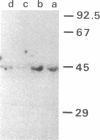Abstract
The human hepatoma cell line, HepG2, secreted an activity that degrades platelet-activating factor (PAF) by the hydrolysis of the sn-2 acetyl group. This activity was Ca++ independent, inhibited by diisopropylfluorophosphate but not by p-bromophenacyl bromide, and resistant to treatment with trypsin or pronase. Separation of HepG2-conditioned medium by gel filtration disclosed that the activity was associated with lipoproteins. An antiserum against PAF acetylhydrolase immunoprecipitated this activity. It was not recognized by an antibody against lecithin:cholesterol acyltransferase (LCAT), which also is secreted by HepG2 cells. Therefore the phospholipase A2 activity of LCAT was excluded as a source of the observed activity. PAF added to the culture medium stimulated the secretion of the PAF-degrading activity by HepG2 cells, while lyso-PAF was inactive. Maximal stimulation was observed with 5 ng/ml PAF, which induced a fivefold increase. The presence of 5 ng/ml PAF, enhanced the secretion of [35S]methionine-labeled PAF acetylhydrolase and cycloheximide inhibited both the basal and PAF-stimulated secretion of the labeled enzyme. We conclude that HepG2 cells produce PAF acetylhydrolase. The liver may be a major source of plasma PAF acetylhydrolase, and PAF may induce the production of its inactivating enzyme by the liver.
Full text
PDF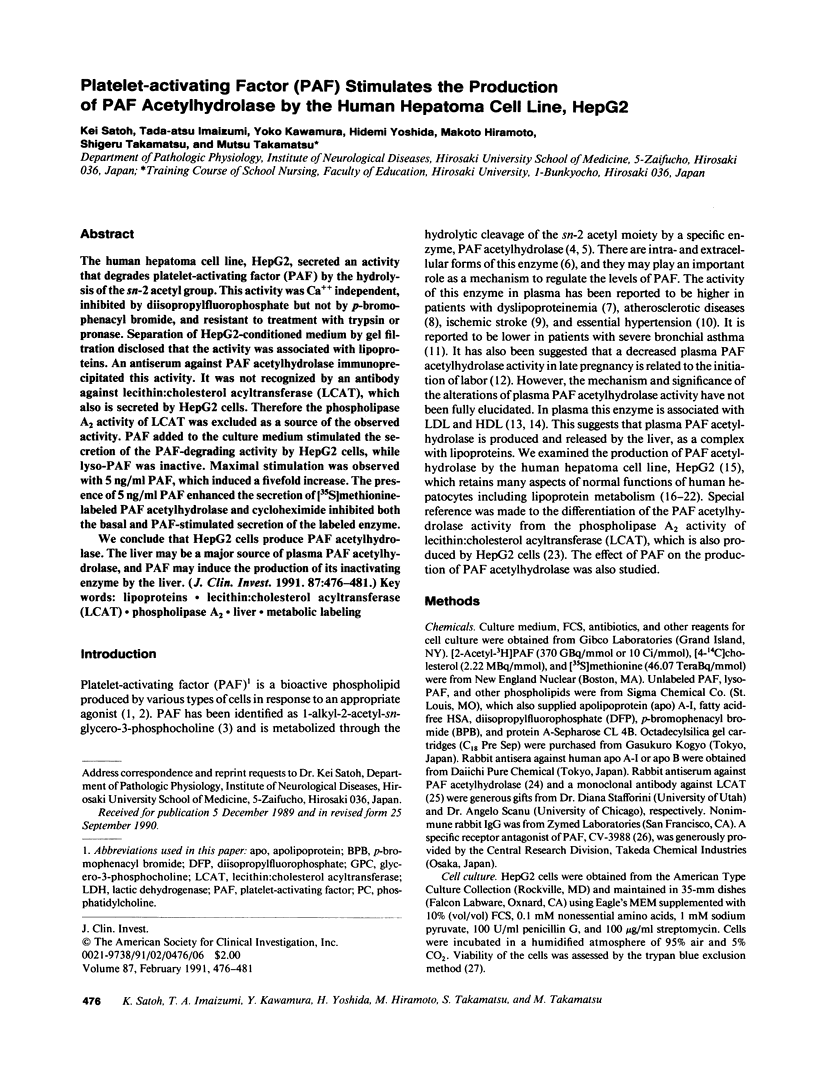
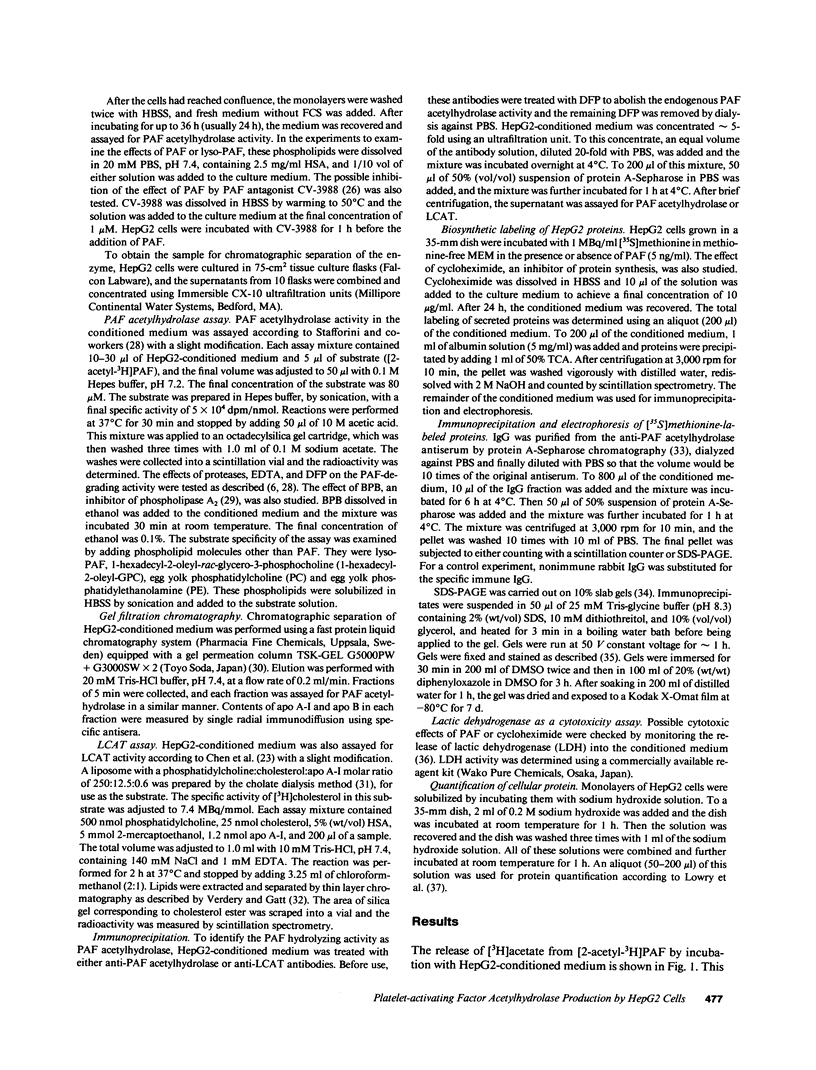
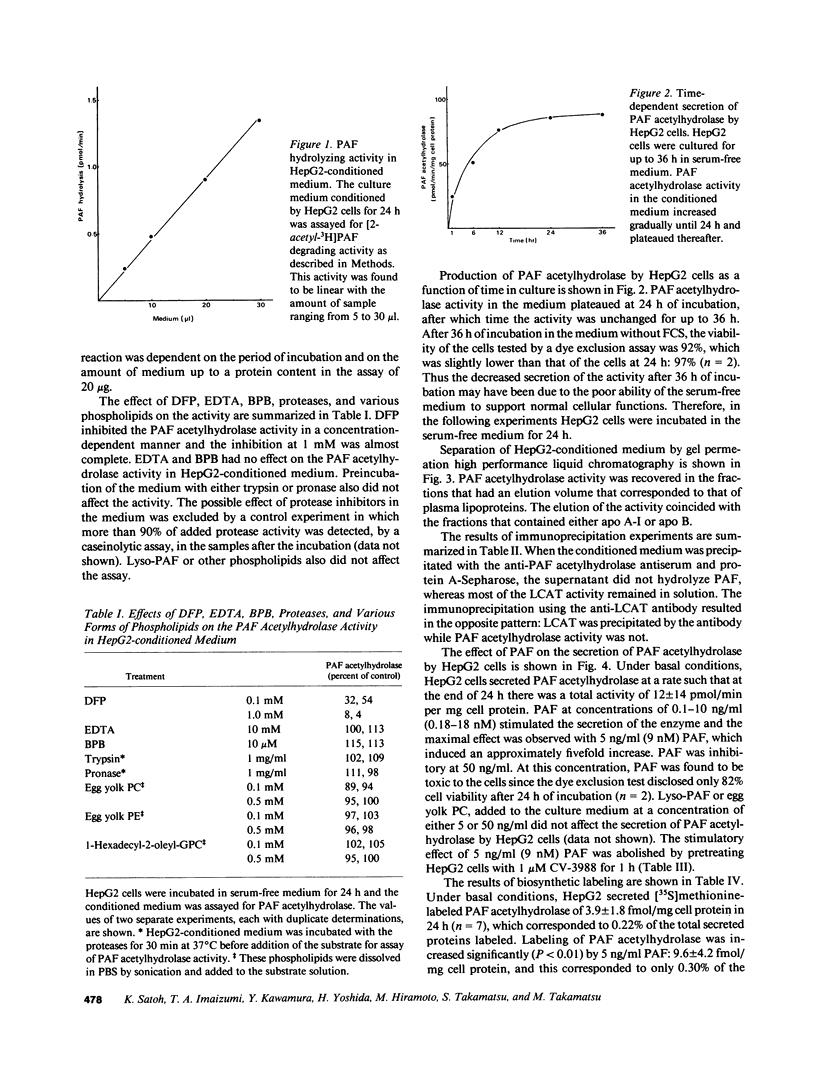
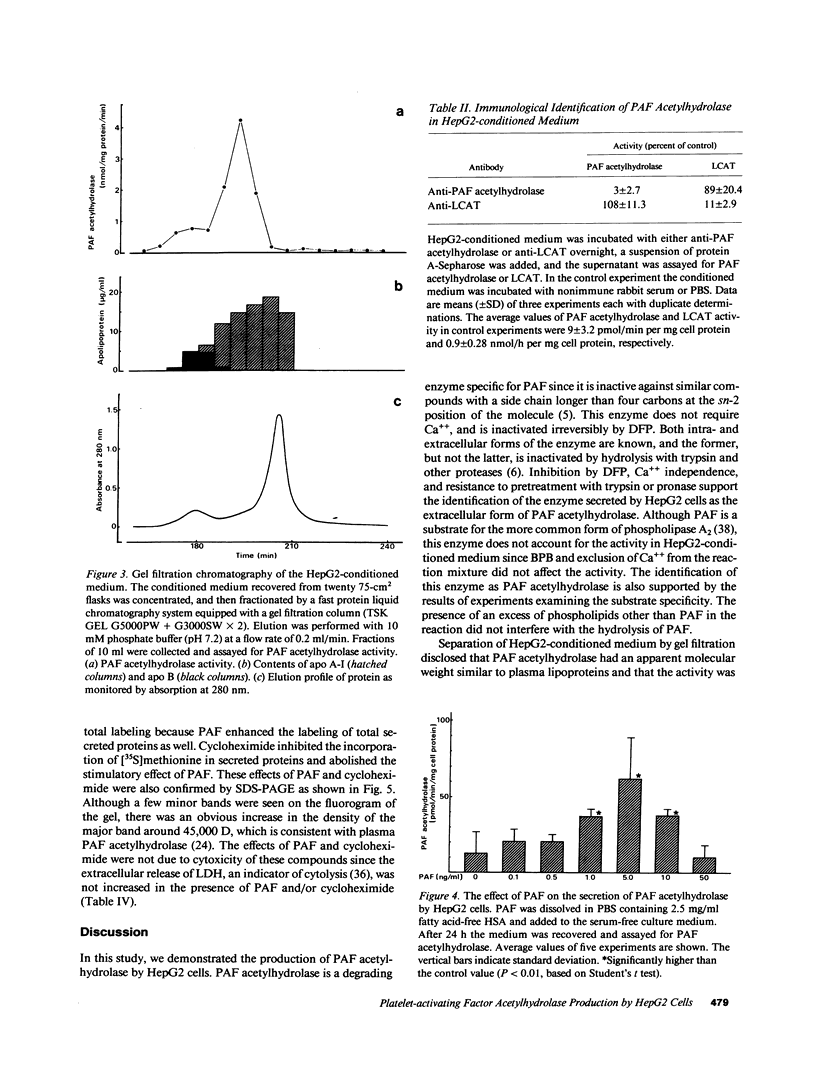
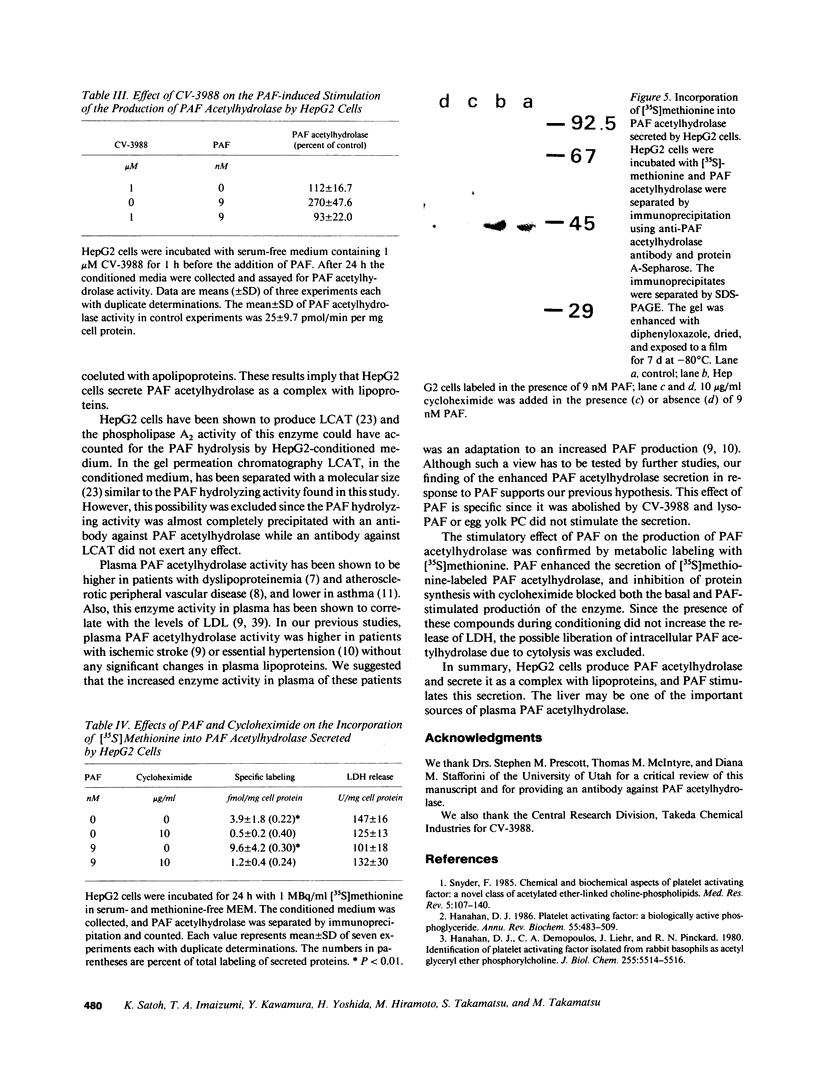
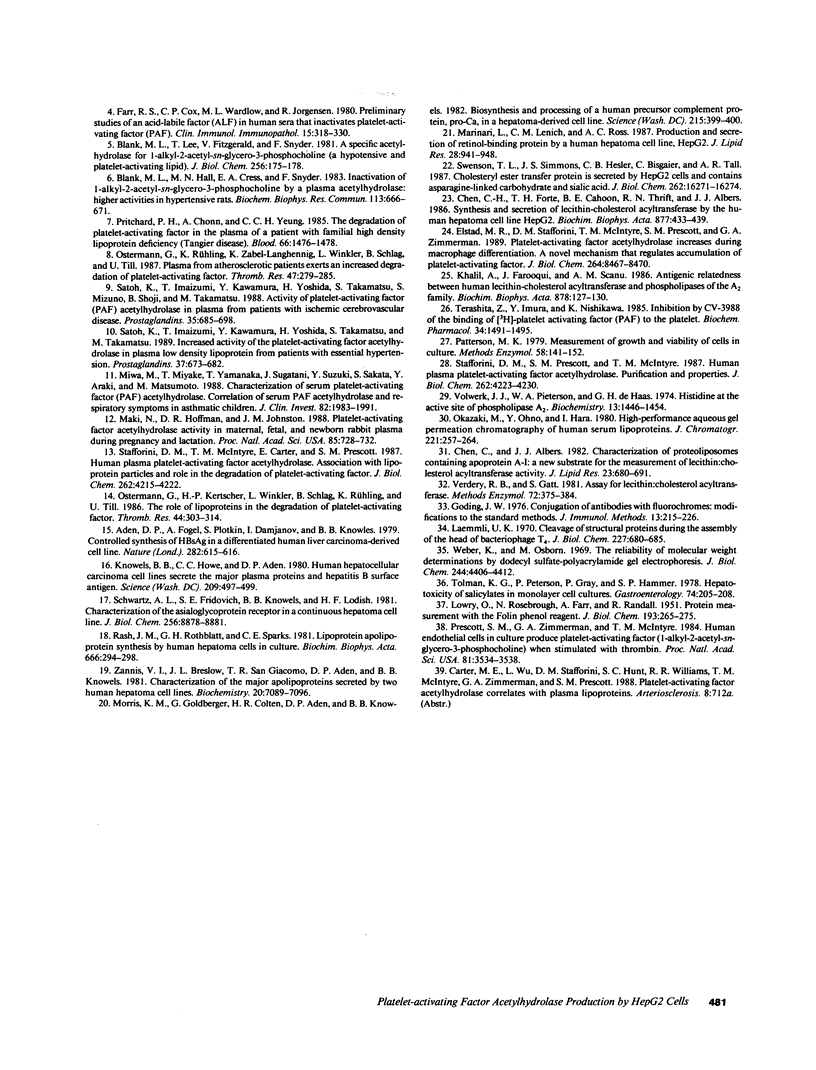
Images in this article
Selected References
These references are in PubMed. This may not be the complete list of references from this article.
- Aden D. P., Fogel A., Plotkin S., Damjanov I., Knowles B. B. Controlled synthesis of HBsAg in a differentiated human liver carcinoma-derived cell line. Nature. 1979 Dec 6;282(5739):615–616. doi: 10.1038/282615a0. [DOI] [PubMed] [Google Scholar]
- Blank M. L., Hall M. N., Cress E. A., Snyder F. Inactivation of 1-alkyl-2-acetyl-sn-glycero-3-phosphocholine by a plasma acetylhydrolase: higher activities in hypertensive rats. Biochem Biophys Res Commun. 1983 Jun 15;113(2):666–671. doi: 10.1016/0006-291x(83)91778-3. [DOI] [PubMed] [Google Scholar]
- Blank M. L., Lee T., Fitzgerald V., Snyder F. A specific acetylhydrolase for 1-alkyl-2-acetyl-sn-glycero-3-phosphocholine (a hypotensive and platelet-activating lipid). J Biol Chem. 1981 Jan 10;256(1):175–178. [PubMed] [Google Scholar]
- Chen C. H., Albers J. J. Characterization of proteoliposomes containing apoprotein A-I: a new substrate for the measurement of lecithin: cholesterol acyltransferase activity. J Lipid Res. 1982 Jul;23(5):680–691. [PubMed] [Google Scholar]
- Chen C. H., Forte T. H., Cahoon B. E., Thrift R. N., Albers J. J. Synthesis and secretion of lecithin-cholesterol acyltransferase by the human hepatoma cell line HepG2. Biochim Biophys Acta. 1986 Jul 18;877(3):433–439. doi: 10.1016/0005-2760(86)90209-2. [DOI] [PubMed] [Google Scholar]
- Elstad M. R., Stafforini D. M., McIntyre T. M., Prescott S. M., Zimmerman G. A. Platelet-activating factor acetylhydrolase increases during macrophage differentiation. A novel mechanism that regulates accumulation of platelet-activating factor. J Biol Chem. 1989 May 25;264(15):8467–8470. [PubMed] [Google Scholar]
- Farr R. S., Cox C. P., Wardlow M. L., Jorgensen R. Preliminary studies of an acid-labile factor (ALF) in human sera that inactivates platelet-activating factor (PAF). Clin Immunol Immunopathol. 1980 Mar;15(3):318–330. doi: 10.1016/0090-1229(80)90044-6. [DOI] [PubMed] [Google Scholar]
- Goding J. W. Conjugation of antibodies with fluorochromes: modifications to the standard methods. J Immunol Methods. 1976;13(3-4):215–226. doi: 10.1016/0022-1759(76)90068-5. [DOI] [PubMed] [Google Scholar]
- Hanahan D. J., Demopoulos C. A., Liehr J., Pinckard R. N. Identification of platelet activating factor isolated from rabbit basophils as acetyl glyceryl ether phosphorylcholine. J Biol Chem. 1980 Jun 25;255(12):5514–5516. [PubMed] [Google Scholar]
- Hanahan D. J. Platelet activating factor: a biologically active phosphoglyceride. Annu Rev Biochem. 1986;55:483–509. doi: 10.1146/annurev.bi.55.070186.002411. [DOI] [PubMed] [Google Scholar]
- Khalil A., Farooqui J., Scanu A. M. Antigenic relatedness between human lecithin-cholesterol acyltransferase and phospholipases of the A2 family. Biochim Biophys Acta. 1986 Aug 14;878(1):127–130. doi: 10.1016/0005-2760(86)90350-4. [DOI] [PubMed] [Google Scholar]
- Knowles B. B., Howe C. C., Aden D. P. Human hepatocellular carcinoma cell lines secrete the major plasma proteins and hepatitis B surface antigen. Science. 1980 Jul 25;209(4455):497–499. doi: 10.1126/science.6248960. [DOI] [PubMed] [Google Scholar]
- LOWRY O. H., ROSEBROUGH N. J., FARR A. L., RANDALL R. J. Protein measurement with the Folin phenol reagent. J Biol Chem. 1951 Nov;193(1):265–275. [PubMed] [Google Scholar]
- Laemmli U. K. Cleavage of structural proteins during the assembly of the head of bacteriophage T4. Nature. 1970 Aug 15;227(5259):680–685. doi: 10.1038/227680a0. [DOI] [PubMed] [Google Scholar]
- Maki N., Hoffman D. R., Johnston J. M. Platelet-activating factor acetylhydrolase activity in maternal, fetal, and newborn rabbit plasma during pregnancy and lactation. Proc Natl Acad Sci U S A. 1988 Feb;85(3):728–732. doi: 10.1073/pnas.85.3.728. [DOI] [PMC free article] [PubMed] [Google Scholar]
- Marinari L., Lenich C. M., Ross A. C. Production and secretion of retinol-binding protein by a human hepatoma cell line, HepG2. J Lipid Res. 1987 Aug;28(8):941–948. [PubMed] [Google Scholar]
- Miwa M., Miyake T., Yamanaka T., Sugatani J., Suzuki Y., Sakata S., Araki Y., Matsumoto M. Characterization of serum platelet-activating factor (PAF) acetylhydrolase. Correlation between deficiency of serum PAF acetylhydrolase and respiratory symptoms in asthmatic children. J Clin Invest. 1988 Dec;82(6):1983–1991. doi: 10.1172/JCI113818. [DOI] [PMC free article] [PubMed] [Google Scholar]
- Morris K. M., Goldberger G., Colten H. R., Aden D. P., Knowles B. B. Biosynthesis and processing of a human precursor complement protein, pro-C3, in a hepatoma-derived cell line. Science. 1982 Jan 22;215(4531):399–400. doi: 10.1126/science.7199205. [DOI] [PubMed] [Google Scholar]
- Okazaki M., Ohno Y., Hara I. High-performance aqueous gel permeation chromatography of human serum lipoproteins. J Chromatogr. 1980 Dec 12;221(2):257–264. doi: 10.1016/s0378-4347(00)84310-8. [DOI] [PubMed] [Google Scholar]
- Ostermann G., Kertscher H. P., Winkler L., Schlag B., Rühling K., Till U. The role of lipoproteins in the degradation of platelet-activating factor. Thromb Res. 1986 Nov 1;44(3):303–314. doi: 10.1016/0049-3848(86)90005-8. [DOI] [PubMed] [Google Scholar]
- Ostermann G., Rühling K., Zabel-Langhennig R., Winkler L., Schlag B., Till U. Plasma from atherosclerotic patients exerts an increased degradation of platelet-activating factor. Thromb Res. 1987 Aug 1;47(3):279–285. doi: 10.1016/0049-3848(87)90141-1. [DOI] [PubMed] [Google Scholar]
- Patterson M. K., Jr Measurement of growth and viability of cells in culture. Methods Enzymol. 1979;58:141–152. doi: 10.1016/s0076-6879(79)58132-4. [DOI] [PubMed] [Google Scholar]
- Prescott S. M., Zimmerman G. A., McIntyre T. M. Human endothelial cells in culture produce platelet-activating factor (1-alkyl-2-acetyl-sn-glycero-3-phosphocholine) when stimulated with thrombin. Proc Natl Acad Sci U S A. 1984 Jun;81(11):3534–3538. doi: 10.1073/pnas.81.11.3534. [DOI] [PMC free article] [PubMed] [Google Scholar]
- Pritchard P. H., Chonn A., Yeung C. C. The degradation of platelet-activating factor in the plasma of a patient with familial high density lipoprotein deficiency (Tangier disease). Blood. 1985 Dec;66(6):1476–1478. [PubMed] [Google Scholar]
- Rash J. M., Rothblat G. H., Sparks C. E. Lipoprotein apolipoprotein synthesis by human hepatoma cells in culture. Biochim Biophys Acta. 1981 Nov 23;666(2):294–298. doi: 10.1016/0005-2760(81)90120-x. [DOI] [PubMed] [Google Scholar]
- Satoh K., Imaizumi T., Kawamura Y., Yoshida H., Takamatsu S., Mizono S., Shoji B., Takamatsu M. Activity of platelet-activating factor (PAF) acetylhydrolase in plasma from patients with ischemic cerebrovascular disease. Prostaglandins. 1988 May;35(5):685–698. doi: 10.1016/0090-6980(88)90142-6. [DOI] [PubMed] [Google Scholar]
- Satoh K., Imaizumi T., Kawamura Y., Yoshida H., Takamatsu S., Takamatsu M. Increased activity of the platelet-activating factor acetylhydrolase in plasma low density lipoprotein from patients with essential hypertension. Prostaglandins. 1989 Jun;37(6):673–682. doi: 10.1016/0090-6980(89)90104-4. [DOI] [PubMed] [Google Scholar]
- Schwartz A. L., Fridovich S. E., Knowles B. B., Lodish H. F. Characterization of the asialoglycoprotein receptor in a continuous hepatoma line. J Biol Chem. 1981 Sep 10;256(17):8878–8881. [PubMed] [Google Scholar]
- Snyder F. Chemical and biochemical aspects of platelet activating factor: a novel class of acetylated ether-linked choline-phospholipids. Med Res Rev. 1985 Jan-Mar;5(1):107–140. doi: 10.1002/med.2610050105. [DOI] [PubMed] [Google Scholar]
- Stafforini D. M., McIntyre T. M., Carter M. E., Prescott S. M. Human plasma platelet-activating factor acetylhydrolase. Association with lipoprotein particles and role in the degradation of platelet-activating factor. J Biol Chem. 1987 Mar 25;262(9):4215–4222. [PubMed] [Google Scholar]
- Stafforini D. M., Prescott S. M., McIntyre T. M. Human plasma platelet-activating factor acetylhydrolase. Purification and properties. J Biol Chem. 1987 Mar 25;262(9):4223–4230. [PubMed] [Google Scholar]
- Swenson T. L., Simmons J. S., Hesler C. B., Bisgaier C., Tall A. R. Cholesteryl ester transfer protein is secreted by Hep G2 cells and contains asparagine-linked carbohydrate and sialic acid. J Biol Chem. 1987 Dec 5;262(34):16271–16274. [PubMed] [Google Scholar]
- Terashita Z., Imura Y., Nishikawa K. Inhibition by CV-3988 of the binding of [3H]-platelet activating factor (PAF) to the platelet. Biochem Pharmacol. 1985 May 1;34(9):1491–1495. doi: 10.1016/0006-2952(85)90689-6. [DOI] [PubMed] [Google Scholar]
- Tolman K. G., Peterson P., Gray P., Hammar S. P. Hepatotoxicity of salicylates in monolayer cell cultures. Gastroenterology. 1978 Feb;74(2 Pt 1):205–208. [PubMed] [Google Scholar]
- Verdery R. B., 3rd, Gatt S. Assay for lecithin: cholesterol acyltransferase. Methods Enzymol. 1981;72:375–384. doi: 10.1016/s0076-6879(81)72027-5. [DOI] [PubMed] [Google Scholar]
- Volwerk J. J., Pieterson W. A., de Haas G. H. Histidine at the active site of phospholipase A2. Biochemistry. 1974 Mar 26;13(7):1446–1454. doi: 10.1021/bi00704a020. [DOI] [PubMed] [Google Scholar]
- Weber K., Osborn M. The reliability of molecular weight determinations by dodecyl sulfate-polyacrylamide gel electrophoresis. J Biol Chem. 1969 Aug 25;244(16):4406–4412. [PubMed] [Google Scholar]
- Zannis V. I., Breslow J. L., SanGiacomo T. R., Aden D. P., Knowles B. B. Characterization of the major apolipoproteins secreted by two human hepatoma cell lines. Biochemistry. 1981 Dec 8;20(25):7089–7096. doi: 10.1021/bi00528a006. [DOI] [PubMed] [Google Scholar]



